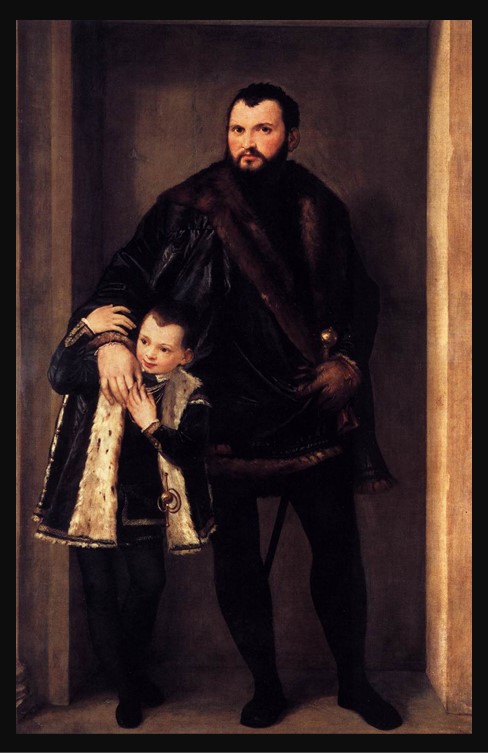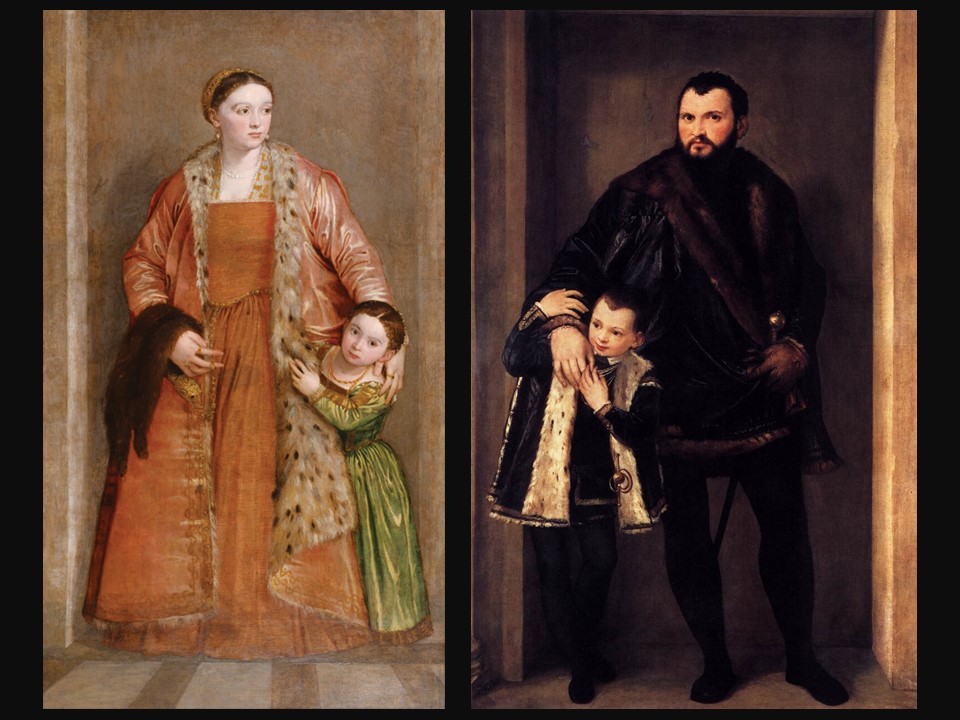
Portrait of Iseppo da Porto and his son Adriano, circa 1555, Oil on Canvas, 247×133 cm, Uffizi Gallery, Florence, Italy https://commons.wikimedia.org/wiki/File:Paolo_Veronese_041.jpg
On Father’s Day consider the majestic, full-length portraits by Veronese, which celebrated the da Porto family, showcasing Count Issepo da Porto and his son Adriano alongside Countess Livia da Porto Thiene and her Daughter Deidamia. These paintings, originally placed in their Vicenza palace designed by Andrea Palladio, symbolize a family’s enduring connection and heritage. Just as Veronese’s art captures the richness of family life and the protection and care provided by fathers, Father’s Day allows us to honour and appreciate the fathers and father figures who have shaped our lives with their love and guidance.

Portrait of Countess Livia da Porto Thiene and her Daughter Deidamia, 1552, Oil on Canvas, 208.40×121 mm, Walters Art Museum, Baltimore, USA https://commons.wikimedia.org/wiki/File:Paolo_Veronese_-_Portrait_of_Countess_Livia_da_Porto_Thiene_and_her_Daughter_Deidamia_-_Google_Art_Project.jpg
Portrait of Iseppo da Porto and his son Adriano, circa 1555, Oil on Canvas, 247×133 cm, Uffizi Gallery, Florence, Italy https://commons.wikimedia.org/wiki/File:Paolo_Veronese_041.jpg
The artist who created the double portraits, Father and Son, Mother and Daughter, of the da Porta family is Paolo Veronese, born Paolo Caliari in 1528 in Verona, Italy, one of the most prominent painters of the Venetian Renaissance. Trained in the workshop of local master Antonio Badile, Veronese’s early work reflects the influence of his native city’s art and architecture. Moving to Venice in the early 1550s marked a significant turning point in his career, allowing him to immerse himself in the city’s vibrant artistic community. Known for his vivid use of colour, dynamic compositions, and grandiose themes, Veronese quickly established himself as a master of large-scale paintings, creating works that adorned palaces, churches, and public buildings. His integration of classical themes with contemporary Venetian culture, coupled with his skilful rendering of fabrics, textures, and architectural elements, distinguished him from his contemporaries and earned him widespread acclaim.
Among Veronese’s most notable achievements are his grand frescoes and altarpieces, such as the Feast in the House of Levi and the Wedding at Cana, which showcase his ability to blend narrative complexity with a sense of opulence and theatricality. His portraits, on the other hand, like those of the da Porta family, demonstrate his keen ability to capture individual character and status, further cementing his reputation as a master portraitist. Veronese’s work not only exemplified the ideals of the High Renaissance but also laid the groundwork for the Baroque movement that followed. His legacy endures through his contributions to the development of Venetian art, influencing generations of artists and securing his place in the pantheon of great Renaissance painters.
Count Issepo da Porto, a nobleman from Vicenza, and his young son Adriano, painted by Paolo Veronese around 1555, make a masterful representation of Renaissance portraiture. Veronese’s skilful use of colour, light, and composition creates a striking and intimate portrayal of the father and son duo. In the portrait, Count Issepo da Porto is depicted standing, exuding an air of authority and elegance. He is dressed in luxurious Renaissance attire, characterized by rich, very dark fabrics and elaborate details, which signify his high social status. The count’s pose is dignified, with one hand resting on his hip and the other gently placed over his son’s shoulder, establishing a sense of connection and paternal care. His facial expression is composed and confident, reflecting his stature and the responsibilities that come with his position.
Adriano, the count’s first-born son, stands beside him, dressed in similarly fine clothing, lighter in tone, that mirrors his father’s, suggesting both the boy’s noble lineage and the care taken in his upbringing. Adriano’s pose is more relaxed, illustrating a sense of affection and dependence. The interaction between the two figures conveys a tender familial bond, enhanced by Veronese’s attention to the details of their postures, expressions, clothing, and the subtle interplay of light and shadow.
The background of the painting is relatively subdued, focusing the viewer’s attention on the figures and their relationship. Veronese’s use of colour, particularly the rich, dark, and warm tones, and the meticulous rendering of textures, such as the fabrics and the skin tones, demonstrate his mastery in creating lifelike and engaging portraits. The Portrait of Count Issepo da Porto and his son Adriano not only captures the likeness of the subjects but also conveys a narrative of lineage, status, and the deep familial connection between father and son.
For a PowerPoint, titled 10 Masterpieces by Paolo Veronese, please… Check HERE!